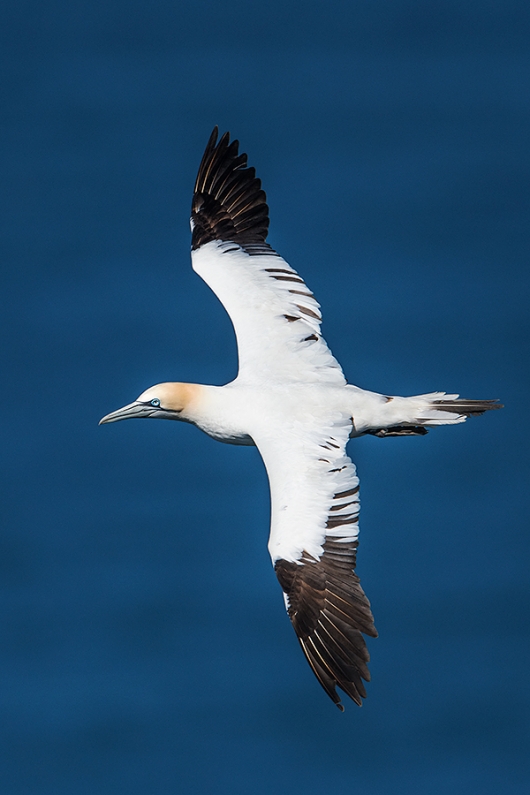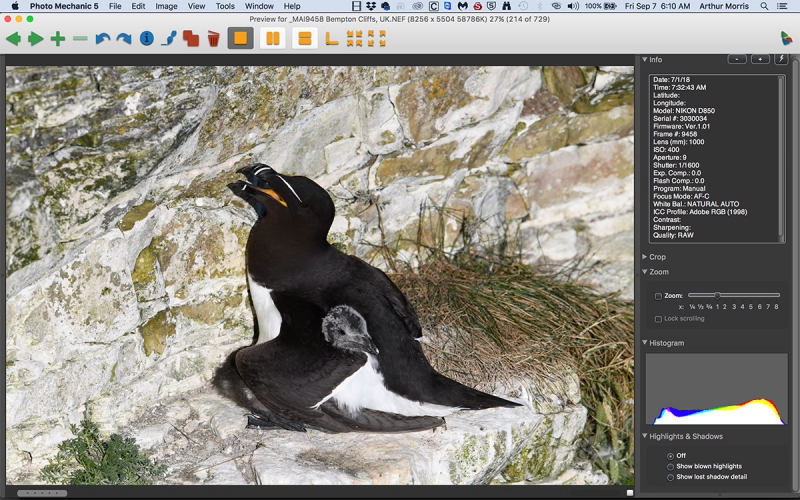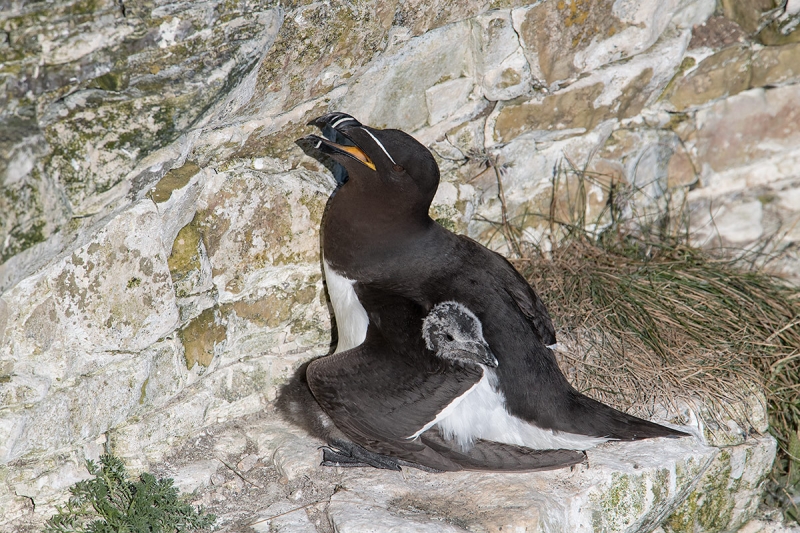Stuff
Been watching lots of sports on the tube and on TIVO this weekend. The BMW Championship, the US Open tennis, and lots of NFL games coming this afternoon on NFL package 🙂
I was glad to learn that Amy Novotny’s Nikon TC-E-20 (teleconverter) sold the first day it was listed.
Both Fall Fort DeSoto IPTs are wide open — click here and scroll down for more info. Details for the 2019 UK Puffins and Gannets IPT will be announced here very soon. We will be visiting Seahouses for the puffins and other seabirds and both Bempton Cliffs and Dunbar (two boat trips) for gannets (and more). If you are interested in the pre-publication details, please shoot me an e-mail. Limit: 10 photographers.
News on the Galapagos Front/Limit 12/Openings: 3
Right now I have nine folks committed to the 2019 Galapagos Photo Cruise. A friend who had committed to the trip learned that he and his wife might not be able to attend. Thus, I have room for a couple or for two same-sex roommates, and for a male single. If the archipelago is on your bucket list, please get in touch via e-mail asap with questions. If you might be registering with a friend or a spouse do ask about the two at a time discount. See the complete details here.
BIRDS AS ART
BIRDS AS ART is registered in the U.S. Patent and Trademark Office.


Selling Your Used Photo Gear Through BIRDS AS ART
Selling your used (or like-new) photo gear through the BAA Blog is a great idea. We charge only a 5% commission. One of the more popular used gear for sale sites charged a minimum of 20%. Plus assorted fees! Yikes. They went out of business. And e-Bay fees are now up to 13%. The minimum item price here is $500 (or less for a $25 fee). If you are interested please scroll down here or shoot us an e-mail with the words Items for Sale Info Request cut and pasted into the Subject line :). Stuff that is priced fairly — I offer pricing advice to those who agree to the terms — usually sells in no time flat. Over the past year, we have sold many dozens of items. Do know that prices on some items like the EOS-1D Mark IV, the old Canon 100-400, the old 500mm, the EOS-7D and 7D Mark II and the original 400mm DO lens have been dropping steadily. You can always see the current listings by clicking on the Used Photo Gear tab on the orange-yellow menu bar near the top of each blog post page.
Unsolicited, via e-mail, from Pierre Williot
I would encourage anyone who wants to sell some of their photographic equipment to contact Art. High-end photographic equipment can be difficult to sell. Art, with is widely read daily posts, will allow you to sell your equipment fairly easily for a reasonable price and commission. Please, seriously consider the price that he suggests as it can be hard to face the reality of the actual value of well loved equipment! Art is well aware of the current market for second-hand photographic equipment.
Used Gear Page News
After a month or so in the summer doldrums, sales on the Used Gear page have been red hot for the past two weeks:
Anthony Ardito sold his Canon EF 24-70mm f/2.8L II USM lens in like-new condition for $999.00 in mid-August.
I sold my Canon 100-400 L IS II in very good plus (almost excellent) condition and in perfect working order for $1399.00 in late August.
Anthony Ardito sold a Canon EOS-1DX Mark II body (with extras) in like-new condition (less than 41,000 actuations)for $3,999.00 in late August.
Roger Williams sold a Canon EF 70-200mm f/2.8 IS II USM lens in like-new condition (but for a single faint scratch on the front element)for the “it’s-your-lucky-day” price of only $899.00 a week after it was listed.
Dane Johnson sold a Canon EOS 40D kit with the body converted to Deep Infrared by Life Pixel in near-mint condition for $549.00 in August, 2918 on the first day it was listed.
Jamie Baker sold his Nikon AF-S Teleconverter TC-20E III in near-mint condition for $299.00 in late August.
John Lowin sold a (men’s extra large) Xtrahand Magnum vest by Vested Interest for $229.00 within a day or two of listing it in late August, 2018.
Anthony Ardito sold his Canon EF 16-35mm f/4L IS USM lens in like-new condition for BAA record-low by far price of $449.00, his Canon EF 100-400mm f4.5-5.6L IS II USM lens in like-new condition for $1,499.00, his Canon EF 70-200mm f/2.8L IS II USM lens in like-new condition for $1,099.00, his Canon Speedlite (flash) 600EX-RT flash in like-new condition for $399.00, his Tamron SP 150-600mm f/5-6.3 lens (for Canon mount) in near-mint condition for $250.00, and his Sigma 50mm f/1.4 DG HSM Art Lens for Canon EF mount in like new condition for $399.00, all with a day or two of their being listed.
Pierre Williot sold his Canon EOS-1DX Mark II in mint condition with less than 75,000 actuations (rated to 400,000) for $4,199.00 in late August.
Todd Koudelka sold his Canon EF 500mm f/4L IS USM lens (“the “old five”) in very good plus condition for the BAA record-low price of $3199.00.
Pierre Williot sold his canon EF 600mm f/4L IS USM lens (the original 600 IS) in very good to excellent condition for $3999.00 in mid-August.
Todd Koudelka sold a Canon EOS 5D Mark IV in near-mint condition (but for a few tiny, barely visible scratches) for the BAA record-low-by-far of $2249.00 (was $2449.00) in early August.
Ron Gates requested that the listing for his Canon 70-200mm lens be removed and kindly sent me a check for 4% of the original asking price.
Julie Brown sold her Canon EF 300mm f/2.8 L IS lens (the original version) in excellent condition for $2099 in early August.
You can see all the listings here.
Money Saving Reminder
If you need a hot photo item that is out of stock at B&H, would enjoy free overnight shipping, and would like a $50 discount on your first purchase, click here to order and enter the coupon code BIRDSASART at checkout. If you are looking to strike a deal on Canon or Nikon gear (including the big telephotos) or on a multiple item order, contact Steve Elkins via e-mail or on his cell at (479) 381-2592 (Eastern time) and be sure to mention your BIRDSASART coupon code and use it for your online order. Steve currently has several D850s in stock along with a Nikon 600mm f/4 VR. He is taking pre-orders for the new Nikon 500 P and the Nikon Z6 mirrorless camera body.
Via e-mail from Anthony Ardito
FYI, I got a D850 & a 200-500 from Bedfords using your BIRDSASART code at checkout. Plus, Steve Elkins gave me a discount and some nice XQD freebies. I have to thank you for that!
Booking.Com
Several folks on the UK IPT used the Booking.Com link below for there Edinburgh hotels, got great rates, and saved a handsome $25.00 in the process. If you too would like to give Booking.Com a shot, click here and to earn a $25 reward on your first booking. Thanks to the many who have already tried and used this great service.
Gear Questions and Advice
Too many folks attending BAA IPTs and dozens of photographers whom I see in the field and on BPN, are–out of ignorance–using the wrong gear especially when it comes to tripods and more especially, tripod heads… Please know that I am always glad to answer your gear questions via e-mail. Those questions might deal with systems, camera bodies, accessories, and/or lens choices and decisions.
|
|
|
This image was created on June 30, 2018 at Bempton Cliffs, UK with the Induro GIT 304L/Mongoose M3.6-mounted Nikon AF-S NIKKOR 600mm f/4E FL ED VR lens, the Nikon AF-S Teleconverter TC-14E III, and my souped up Nikon D850. ISO 800. Matrix metering +1 2/3 stops off the grey sky: 1/5000 sec. at f/6.3 in Manual mode. Natural Auto WB at 4:43PM on an absolutely clear afternoon. Center group (grp) Continuous (AI Servo in Canon) shutter button AF was active at the moment of exposure. The upper point in the array was on the top of the gannet’s head; that is about as good as I can do. Phase detection AF Fine-tune value: +5. See the Nikon AF Fine-tune e-Guide here. Photo Mechanic screen capture
|
Northern Gannet Top Shots with Blue Water Backgrounds, a Dime a Dozen
While the unusually clear, sunny, warm weather made things tough on us on several mornings, the afternoons were spectacular. The gannets consistently fly by below eye level offering unlimited chances for spectacular top shots, images of birds in flight showing the dorsal wing surfaces. On some winds you can use your hand held intermediate telephotos and do just fine. On other winds a longer lens is often the best too.
Though I did try to create some vertical originals, today’s featured image is a crop from a horizontal original.
Another High Level Exposure Question
As of 10:48am no one has come up with the exposure question in Friday’s blog post that dealt with the underexposure of the Razorbill’s middle-toned, amber colored iris. Today’s question is pretty much the same: why is the water rendered a much darker blue than it was in life? (I have a feeling that even though the question is the same that for some reason, this one might be easier for folks to understand …
Help Support the Blog
Please help support my efforts here on the blog by remembering to click on the logo link above each time that you shop Amazon. That would be greatly appreciated. There is no problem using your Prime account; just click on the link and log into your Prime account. With love, artie
If In Doubt …
If in doubt about using the BAA B&H affiliate link correctly, you can always start your search by clicking here. Please note that the tracking is invisible. Web orders only. Please, however, remember to shoot me your receipt via e-mail.




Please Remember to use my Affiliate Links and to Visit the New BAA Online Store 🙂
To show your appreciation for my continuing efforts here, we ask, as always, that you get in the habit of using my B&H affiliate links on the right side of the blog for all of your photo and electronics purchases. Please check the availability of all photographic accessories in the New BIRDS AS ART Online Store, especially the Mongoose M3.6 tripod head, Wimberley lens plates, Delkin flash cards and accessories, and LensCoat stuff.
As always, we sell only what I have used, have tested, and can depend on. We will not sell you junk. We know what you need to make creating great images easy and fun. And please remember that I am always glad to answer your gear questions via e-mail.
I would of course appreciate your using our B&H affiliate links for all of your major gear, video, and electronic purchases. For the photographic stuff mentioned in the paragraph above, and for everything else in the new store, we, meaning BAA, would of course greatly appreciate your business. Here is a huge thank you to the many who have been using our links on a regular basis and those who will be visiting the New BIRDS AS ART Online Store as well.
Be sure to like and follow BAA on Facebook by clicking on the logo link upper right. Tanks a stack.
Typos
In all blog posts and Bulletins, feel free to e-mail or to leave a comment regarding any typos or errors. Just be right :).




















